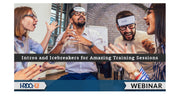Training tools for developing great people skills.

25 Examples of Unconscious Biases and How to Avoid Them
Unconscious biases are mental shortcuts that people use to process information faster– essentially, they are learned attitudes or stereotypes that involuntarily impact how we think and act. As we grow older and have more life experiences under our belts, we continue to develop unconscious (or implicit) biases.
These biases can encompass assessments of all kinds– both positive and negative. Because they are unconscious, it means that we aren't intentionally making these assumptions and aren't even aware of the fact that we are doing so.
Unconscious biases can significantly impact every aspect of an organization– the hiring process, how business decisions are made, and the day-to-day operations and interactions of a company.
For many types of unconscious bias, a valuable first step is to develop an awareness of the bias. Since they are unconscious, an individual typically doesn't have conscious knowledge that their attitudes and beliefs might be impacted by implicit assumptions. Here are examples of common biases.

- Identify areas of low understanding
- Identify cultural strengths
- Improve cross-cultural communication
Table of Contents
- 1. Ageism
- 2. Gender Bias
- 3. Name Bias
- 4. Horns Effect
- 5. Halo Effect
- 6. Conformity Bias
- 7. Confirmation Bias
- 8. Contrast Effect
- 9. Affinity Bias
- 10. Authority Bias
- 11. Anchor Bias
- 12. Attribution Bias
- 13. Status Quo Bias
- 14. Beauty Bias
- 15. Height Bias
- 16. Weight Bias
- 17. Hair Color Bias
- 18. Culture Bias
- 19. Idiosyncratic Rater Bias
- 20. Nonverbal Bias
- 21. Overconfidence Bias
- 22. Illusory Correlation
- 23. Perception Bias
- 24. Recency Bias
- 25. Affect Heuristic
- Dealing With Unconscious Bias in the Workplace
1. Ageism
Ageism refers to prejudice or discrimination against a person based on their age. This bias can be a prevalent issue in many workplaces, even though workers that are 40 or older are protected from discrimination in the workplace under the Age Discrimination in Employment Act.

How to avoid it: To prevent ageism, it's essential to engage older team members and foster cross-generational collaboration. You'll also want to work to ensure you aren't making assumptions about a person's skills or abilities based on their age.
2. Gender Bias
Gender bias is when a person favors one gender over another by associating specific stereotypes with each gender. This type of unconscious bias can have an impact on relationship dynamics within an organization as well as recruitment practices.

How to avoid it: You can do several things to help ensure that gender bias isn't present in your workplace, including setting gender-neutral recruiting standards and providing resources to underrepresented groups in leadership roles.
3. Name Bias
Name bias refers to the unconscious tendency to have an affinity for specific names over others. This bias can be a problem in the recruitment process, as the type of name a person has can influence whether they are offered interviews.

How to avoid it: One way that companies avoid name bias in hiring is to omit the names of candidates when engaging in the applicant screening process. That is something that can be done with the help of blind hiring software or manually by a team member.
4. Horns Effect
The "horns effect" is a phenomenon where one trait or experience with another person can cause us to have a negative impression of them.

How to avoid it: By getting to know people beyond your first impression of them and only making judgments based on evidence, you can work to combat the horns effect.
5. Halo Effect
The opposite of the horns effect, the halo effect is when one positive trait or quality of a person leads us to have an overall positive view of them.

How to avoid it: Rather than putting someone on a pedestal because they have one notable positive trait or performed well in one interview, consider conducting multiple interviews so each applicant can be viewed from multiple angles. Incorporating other team members into the interview process can also be helpful.
6. Conformity Bias
Conformity bias occurs when we alter our behaviors or opinions to match those of the larger group, even when this change in behavior or thought doesn't actually reflect our own opinions. This can be an issue in the workplace as it can limit the diversity of opinion, creativity, and open discussions.

How to avoid it: Conduct private meetings with team members before meetings to get their opinion so that they are not unconsciously impacted by the larger opinion of the group. You can also use anonymous surveys to receive feedback to ensure you are receiving your team's honest views.
7. Confirmation Bias
Confirmation bias occurs when a person has a view or expectation in place and then searches for information that confirms this belief.

How to avoid it: In the recruitment process, you can avoid confirmation bias by standardizing interview questions. As a part of your regular business practices, it's important to utilize multiple sources whenever you are attempting to answer a vital question or conducting research.
8. Contrast Effect
Contrast effects can lead us to perceive things as either better or worse than usual because of the presence of something to compare them to.

How to avoid it: Making comparisons is a common way people make judgments, but it's a good idea to make multiple comparisons rather than just one when working to come to a conclusion.
9. Affinity Bias
Also referred to as the similarity bias, this is the tendency to prefer other people that have similar experiences, backgrounds, and interests as you.

How to avoid it: To prevent affinity bias in hiring, a diverse recruitment panel can help ensure that one person's similarity bias doesn't overwhelmingly impact hiring decisions.
10. Authority Bias
Authority bias is a term to describe the tendency to trust and follow authority figures without thinking critically about the beliefs and instructions of that authority figure.

How to avoid it: Thinking critically, regardless of the source of information, is a powerful antidote to authority bias. Doing your research and asking questions can help ensure you aren't falling prey to this type of unconscious bias.
To ensure that decisions are being made without authority bias or other types of unconscious bias, consider employing our Critical Thinking Skills course.
11. Anchor Bias
When we rely on the first piece of information we receive about a topic to make a decision at the expense of other valuable bits of knowledge, we are guilty of anchor bias.

How to avoid it: You can work to avoid anchor bias by ensuring that you are conducting thorough research and bringing in outside perspectives from your team when making a decision.
12. Attribution Bias
Attribution bias is the tendency to refer to a person's character when explaining or understanding their behavior rather than any situational factor. In short, this means that we underestimate the influence of a person's individual circumstances in how they act and overestimate the influence of their personality traits.

How to avoid it: To avoid attribution bias in the workplace, try to focus on situational or circumstantial factors rather than making assumptions about a person's character or personality influencing their actions.
13. Status Quo Bias
People tend to be resistant to change and have an affinity for keeping things the way they currently are. Though this can require less effort and feel less risky, becoming stagnant means that a company isn't innovating and growing.

How to avoid it: Encouraging innovation, creativity, and outside-the-box thinking can help to avoid status quo bias in the workplace.
14. Beauty Bias
People that are considered more attractive can receive more favorable treatment than people that are considered less attractive. That can result in a form of discrimination that is based on the way a person looks rather than their skills, experience, or other more relevant traits.

How to avoid it: Two tactics you can try to prevent beauty bias in the hiring process is to hold brief phone interviews before having an in-person interview and to omit photographs from resumes.
15. Height Bias
This type of unconscious bias occurs when an individual judges another person based on their height– typically occurring when a person is significantly taller or shorter than the average height.

How to avoid it: Becoming aware of one's own tendency to make assumptions about people based on their height is an essential first step. In hiring, initial phone interviews can help ensure that you focus on the candidate's abilities rather than their physical appearance.
16. Weight Bias
People can also be unconsciously biased toward other people based on their weight. This bias can impact both men and women and people of all backgrounds.

How to avoid it: Similarly to height bias, you can work to ensure that you aren't positively or negatively responding to a candidate because of their weight but instead due to their ability to perform a specific role.
17. Hair Color Bias
Unconscious bias can even rear its ugly head when it comes to a person's hair color, such as the stereotypes that can revolve around people with red or blonde hair.

How to avoid it: Ensuring no photos are attached to resumes before review can help avoid hair color bias.
18. Culture Bias
A type of affinity bias, people can tend to favor people that hold similar cultural values as they do.

How to avoid it: Being aware of one's own cultural bias is an essential first step, as with many different types of unconscious bias. Having a diverse hiring team can also ensure that one individual's cultural bias impacts recruitment decisions.
19. Idiosyncratic Rater Bias
It's common for people to use their own definition of success to make subjective interpretations of other people. Research has found that most people are unreliable when rating other individuals in the workplace.

How to avoid it: Conducting multi-rater reviews and ensuring that specific and clear assessment criteria are in place can help prevent idiosyncratic rater bias.
20. Nonverbal Bias
A person's nonverbal communication can also be a source of unconscious bias. For example, an individual might favor a person with a firm handshake over someone with a weak handshake.

How to avoid it: Being aware of one's own tendency to favor certain types of nonverbal communication over others can help to reduce the occurrence of this type of bias in hiring and in the workplace.
21. Overconfidence Bias
This type of bias refers to the tendency that individuals have to think that they are more skilled at certain abilities than they objectively are. This can lead to making rash decisions based on the assumption that we are more capable than we are.

How to avoid it: Asking for feedback from others is a very effective way to avoid overconfidence bias and ensure you take adequate time to make big decisions and assess all possible risks.
22. Illusory Correlation
Illusory correlation occurs when we link two actions, events, or variables together when they are not associated or connected.

How to avoid it: Viewing a problem or situation from all angles and working to gather as much information as possible can help combat the tendency to make illusory correlations.
23. Perception Bias
When we use overly simplistic stereotypes and assumptions about an individual because of a group that they belong to, perception bias occurs.

How to avoid it: To avoid perception bias in the workplace, it's important to challenge your assumptions and become aware of preconceived notions you have.
24. Recency Bias
Recency bias is the tendency to view recent events with greater importance than events that occurred longer ago.

How to avoid it: Working to improve one's memory can avoid the occurrence of recency bias. For example, ensure you give yourself sufficient breaks when conducting interviews all day, and take notes to help you keep track of each candidate's experience and skills.
25. Affect Heuristic
Our brains make decisions using simple rules of thumb to increase the efficiency of the decision-making process. These mental shortcuts are known as heuristics. The affect heuristic refers to making decisions based on our emotions.

How to avoid it: Working to become more aware of your emotions and taking time to reflect after something has brought about an emotional response can help you avoid the affect heuristic.
Dealing With Unconscious Bias in the Workplace
Unconscious bias can have a much more significant influence on our professional lives than we realize– impacting everything from how we make decisions to how we interact with our team. By becoming more aware of the different types of implicit bias and how they can affect our thoughts, beliefs, and behaviors, we can work to create more trust and productivity in the workplace.

If it's time for you to tackle unconscious bias in your organization, take a look at our Implicit Bias in the Workplace customizable course. This course can help participants understand the nature and origins of unconscious biases, identify practical solutions to circumstances where implicit bias can occur, and much more.
Do you have any questions about unconscious biases, our customizable courses, or anything else related? If so, be sure to drop us a comment down below, and we'll get back to you within a couple of days. We pride ourselves on replying to every comment we receive, and we'd be more than happy to answer any questions you may have.

- Identify areas of low understanding
- Identify cultural strengths
- Improve cross-cultural communication

About our author
Bradford R. Glaser












![[Guide] Mapping the Path of Erikson's Developmental Process](http://hrdqstore.com/cdn/shop/articles/Eriksons_Developmental_Process.jpg?v=1708737452&width=180)












![[Guide] What Is Vroom's Expectancy Theory of Motivation?](http://hrdqstore.com/cdn/shop/articles/A_Motivated_Employee.jpg?v=1702076987&width=180)




















![[Guide] What Are The Different Employee Onboarding Phases? - HRDQ](http://hrdqstore.com/cdn/shop/articles/guide-what-are-the-different-employee-onboarding-phases-549815.jpg?v=1688797514&width=180)







Leave a comment